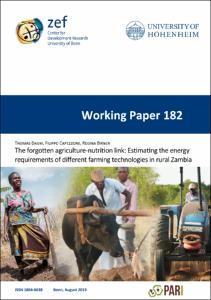The forgotten agriculture-nutrition linkEstimating the energy requirements of different farming technologies in rural Zambia with time-use data

The forgotten agriculture-nutrition link
Estimating the energy requirements of different farming technologies in rural Zambia with time-use data

| dc.contributor.author | Daum, Thomas | |
| dc.contributor.author | Capezzone, Filippo | |
| dc.contributor.author | Birner, Regina | |
| dc.date.accessioned | 2022-05-13T13:22:49Z | |
| dc.date.available | 2022-05-13T13:22:49Z | |
| dc.date.issued | 08.2019 | |
| dc.identifier.uri | https://hdl.handle.net/20.500.11811/9799 | |
| dc.description.abstract | In the quest to reduce global under- and malnutrition, which is particularly high among smallholder farmers, agriculture-nutrition linkages have received a lot of attention in recent years. Researchers have analysed the link between the quantity of food that farmers produce and nutritional outcomes and the link between farm diversity and consumption diversity. A third agriculture-nutrition link has been largely neglected in recent years: the impact of how food is produced on human energy requirements, and, consequently, nutritional outcomes. This neglect persists despite the fact that the majority of smallholder farmers in Sub-Saharan Africa rely on hand tools for farming, which implies heavy physical work and, thus, high energy requirements. To address this research gap, the present study compares the energy requirements of farm households in rural Zambia that are characterized by three different levels of mechanization: hand tools, animal draught power and tractors. Detailed time- use as well as food and nutrition data was collected from male and female adults and from children during different seasons: land preparation, weeding and harvesting/processing. Subjects recorded time-use themselves using an innovative picture-based smartphone app called “Timetracker”. The time-use data served to calculate daily energy requirements using “Ainsworth’s Compendium of Physical Activities”. To analyse the link between mechanization and energy use as well as nutritional outcomes, linear mixed models and multiple linear regressions were used. The results show that during land preparation, individuals in non-mechanized households are, on the average, not able to meet their dietary energy requirements. In subsequent farming periods, results are more mixed. Gender differences are noteworthy throughout, with men mostly having higher physical activity levels and energy requirements compared to women The findings suggest that farm technologies affect nutritional outcomes substantially and that this neglected agriculture-nutrition linkage deserves more scientific and political attention in order to reduce the prevalence of both under- and malnutrition among smallholder farmers, while safeguarding against emerging double burden of nutrition. | en |
| dc.format.extent | 48 | |
| dc.language.iso | eng | |
| dc.relation.ispartofseries | ZEF Working Paper ; 182 | |
| dc.rights | In Copyright | |
| dc.rights.uri | http://rightsstatements.org/vocab/InC/1.0/ | |
| dc.subject | Africa | |
| dc.subject | Agricultural production | |
| dc.subject | Food and nutrition security | |
| dc.subject | Innovation | |
| dc.subject | Mechanization | |
| dc.subject | Crops | |
| dc.subject | Gender | |
| dc.subject.ddc | 630 Landwirtschaft, Veterinärmedizin | |
| dc.title | The forgotten agriculture-nutrition link | |
| dc.title.alternative | Estimating the energy requirements of different farming technologies in rural Zambia with time-use data | |
| dc.type | Arbeitspapier | |
| dc.publisher.name | Center for Development Research (ZEF) | |
| dc.publisher.location | Bonn | |
| dc.rights.accessRights | openAccess | |
| dc.relation.eissn | 1864-6638 | |
| dc.relation.doi | https://doi.org/10.2139/ssrn.3435998 | |
| dc.relation.url | https://www.zef.de/fileadmin/user_upload/ZEF_WP_182.pdf | |
| ulbbn.pubtype | Zweitveröffentlichung |




